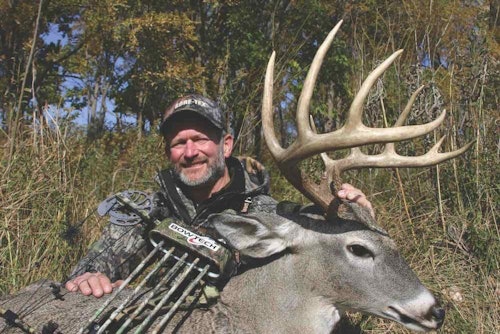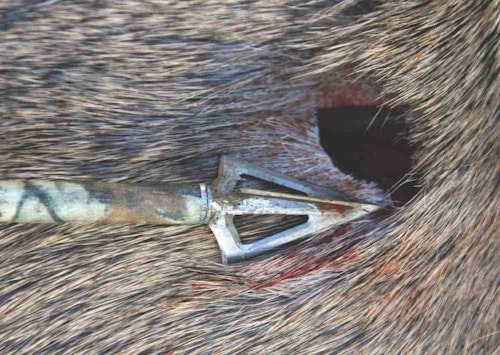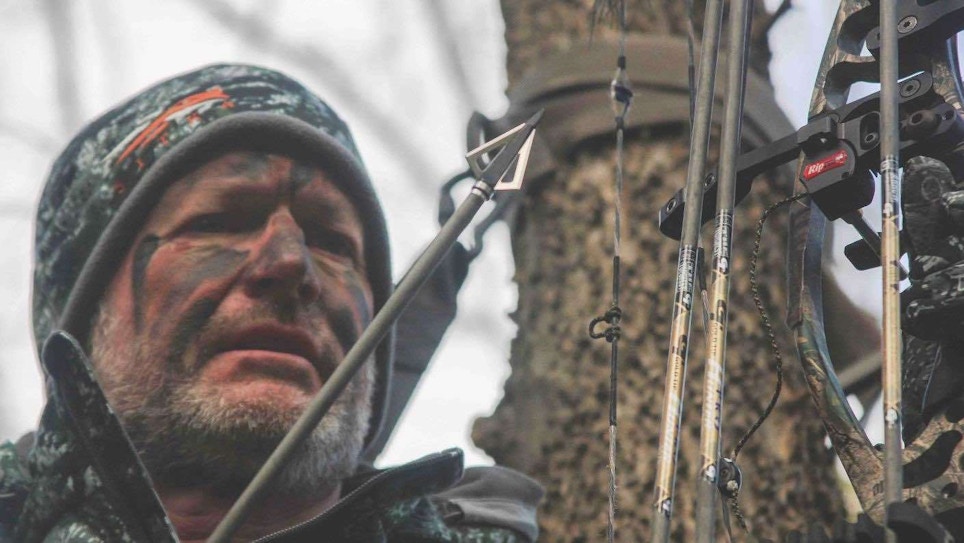In my little home office is a very small collection of ancient broadheads crafted from obsidian and flint by hunters who had much more at stake when it came to sneaking within arrow range of game than we do today. I’ve stumbled across them from time to time as I have traveled the country bowhunting with modern archery tackle, and each time I do they send me off daydreaming about those who came before us.
Upon reflection, one can see that broadheads have really not changed all that much through the years. For example, you can find three-bladed broadheads made from metal that date back to the Bronze Age, some 3,000 years ago; a design very similar to the Trocar tip popularized by Muzzy was built in the 14th century. Its function? To penetrate the chain mail worn by soldiers.
It wasn’t all that long ago that most bowhunters were shooting what were, by today’s standards, large, heavy broadheads that impeded arrow speed. Traditional-style, fixed-blade heads have a lot going for them, though, and they are making a comeback due to YouTube content producers such as The Hunting Public and The Ranch Fairy. These heads are built from one-piece construction typically featuring a main flat blade generally made from welded steel, and they are incredibly strong. Their cut-to-tip design allows for deep penetration, and the combination of heavy head weight and relatively heavy arrow shafts with their bullet-proof construction and razor-sharp edges help them penetrate deeply and crack even the heaviest rib bones.

Almost all bowhunters using longbows and recurves choose traditional heads that can be resharpened. Examples include Bear Razorhead, G5 Montec, Magnus Stinger and Black Hornet, Muzzy One, NAP Hellrazor, Simmons Land Shark, Steel Force Phat Head, Wasp SharpShooter, Zwickey Delta and Eskimo, and others.
The old traditional broadheads often weighed upwards of 200 grains, though modern versions can weigh as little as 100 grains. Perhaps the biggest downside in using any of these heads for the modern bowhunter is the fact that their blades should be hand sharpened for best results, a basic woodsmanship skill that most hunters in the younger generation were never taught.
It was the need for consistently razor-sharp blades that spurred the development of the most popular style of broadhead used today, the replaceable-blade design found in heads such as the G5 Striker, QAD Exodus, and others. Many of today’s bowhunters have never known a time when this style of head was not available, but the basic concept dates back to the 1950s, when innovative California bowhunters such as Jim Dougherty, Jack Doyle and Duke Savora experimented with gluing razor blades from their shaving kits to the three most popular broadhead styles of the day: the fixed-blade MA-3, Bod-Kin and Hill’s Hornet. The technique became relatively common in the region and was a precursor to today’s popular replaceable-blade designs. Doyle began marketing the Zia Scorpion, which was the very first razor-insert broadhead, as well as blades for the glue-on process, in the early 1960s, advertising both in the now-defunct Archery magazine. Duke Savora’s Swept-Wing broadhead, introduced in 1974, was the first mass-produced insert-style head that used replacement blades designed specifically for broadheads. It helped set the stage for the well-designed replaceable-blade broadheads that dominate the contemporary market.
If bowhunters are one thing, they are tinkerers. Looking back, it now seems that what we once thought was off-the-charts radical — the mechanical broadhead — now seems a natural progression that came about by those trying to achieve increased terminal performance and, above all else, accuracy. Though I have never had a problem tuning even a fast compound bow with a replaceable-blade broadhead, some shooters do, and so they began turning to mechanical broadheads that have nearly identical flight characteristics as field points.
To be blunt about it, the first mechanical broadheads basically sucked. They had all sorts of design flaws, they were flimsy, and they didn’t always perform as advertised. So many bowhunters were disappointed with them that for a brief period their future was in doubt. Today, of course, mechanical broadheads have evolved to a point where the best are easy to tune, strong, have razor-sharp blades, and can penetrate as deeply as the best replaceable-blade styles, and their popularity has soared.

Choosing a broadhead is a personal decision. People often ask me which are best, and my answer is always the same: “What do you like best: blondes, brunettes or redheads?” The answer, of course, is “Yes!” Keep in mind that a broadhead has one function, and one function only — to cut a hole through hair, hide, muscle and internal organs. It must be strong enough to withstand some serious abuse and designed so precisely that it can be made to fly like a laser beam. With this in mind, you can eliminate the cheap stuff and choose from one of dozens of broadheads with confidence that fits both your equipment and your personality.
Fact vs. Fiction
It is hard to quantify broadhead performance en masse simply because it is difficult to collect data in sufficient quantity to make a judgment. However we can learn a lot from a study presented at the Southeast Deer Study Group in 2014 by Andy Pedersen, a retired senior engineer at Naval Support Facility Indian Head, a military installation on the Potomac River in Maryland. The base is involved in explosives manufacturing and research, among other things, so the public is not allowed on site. Prior to 1989, sharpshooters were used to control the overpopulation of deer. In 1989, the base’s Natural Resources Office established a formal bowhunting program open to military and civilian employees to help maintain the deer population within the carrying capacity of the habitat. Andy helped get that program running.
Pedersen is a numbers guy, so he lobbied for data-collection requirements. Hunters are required to file reports on whether they shot at, hit or recovered a deer (defined as found within 24 hours). The base’s Natural Resources Office collects biological data, such as live and dressed weights and jawbone age, from every deer killed. The base is not large or heavily hunted. Two areas totaling 3,000 acres are open to hunting; on one of the areas, there is an earn-a-buck requirement, and bucks must net 130 inches Pope and Young. On the other area, there’s no earn-a-buck requirement, and bucks must have at least three points on one side. A total of 209 bowhunters have pursued deer on the base in the 24 seasons in this study.
A total of 135 of the 209 bowhunters recovered at least one deer, dragging out a total of 1,083 deer after putting in 35,011 hours of time on stand. That’s one deer for every 32.5 hours in the field, and an average of about eight deer per successful bowhunter. To get 1,083 deer, hunters reported hitting 1,296 deer from 1989 through 2012 for a recovery rate of 83.6%. Separated by bow type, crossbow hunters had an 89% recovery rate compared to 83% for compound hunters.
When it comes to broadhead type (for both compound and crossbow users), hunters using fixed-blade broadheads recovered 82% of their deer (874 recovered out of 1,066 hit). Those using mechanical broadheads recovered 91% of their deer (209 out of 230 hit). The total number of deer is lower for mechanicals because they have only been approved for use on the base since 2007, although the majority of deer shot since then were shot with mechanicals.
Compound shooters using mechanicals recovered 143 of 161 deer for an 89% recovery rate; those using fixed-blades recovered 821 out of 1,001 deer for an 82% recovery rate. Crossbow hunters using mechanical broadheads recovered 66 out of 69 deer for a 96% recovery rate; those using fixed-blades recovered 53 out of 65 deer for an 82% recovery rate.
Pedersen went so far as to separate fixed-blade recovery rates into pre- and post-mechanical eras. There was no statistically significant difference. Recovery rates with fixed-blade broadheads shot from compound bows were 82.2% from 1989 to 2006 and 81% from 2007 to 2012. For crossbows: 81.7% in the early years, 80% more recently.
How about accuracy? Crossbow users hit their target 94.5% of the time, while compound shooters hit theirs 89.9% of the time. The comparison was almost exactly the same for broadhead type. Mechanical users were slightly higher, hitting the deer 94.3% of the time compared to 89.4% for fixed-blade.
What the data in this study tells us is simple — assuming that the bowhunter is a competent shot with the type of bow chosen, the differences in performance between bow types and broadhead types are small.
Another factor in this lengthy study was that the average shot was less than 20 yards, which lends itself to precise arrow placement. Given that, both mechanical and replaceable-blade heads will get the job done.

Ancient History Today
A few springs back I was turkey hunting in northern Arizona. As I was walking along the banks of a creek, something caught my eye. I stopped and looked again, trying to figure out what it was. There! The angle of the sun was such that it briefly glinted off something shiny. Reaching down, I found it was an ancient obsidian broadhead, one about the size of a 50-cent piece and still in perfect condition. I walked down to the creek and, after washing the mud off the head, I was mesmerized by the way the sun shined off the angles knapped into the sides of this ancient tool.
It was midmorning and the gobblers, for the moment, had given me the slip, so I sat down against the trunk of a giant oak to rest for a while. I bet I turned that broadhead over in the palm of my hand a hundred times, and as I did so I wondered: Did the hunter who carried it afield have success the day it was lost? Did he simply drop it from a small leather bag, or was it shot at a deer or a rabbit? If so, did his arrow hit its mark? Was he young, or old? Was he a skilled hunter, someone able to provide a regular feast of meat for him and his family? Was he able to teach his own sons the secrets of the hunt, as my own father and grandfather had for me?
The broadhead is the ultimate connection between the bowhunter and his prey. We all understand how difficult it is to get a controlled, close-range bow shot at an animal. When we do, the success or failure of the day is totally dependent on whether or not the broadhead does its job. If it does, we whoop and holler and give thanks to the stars above for our good fortune. If it fails, at best we eat tag soup; at worst, we wound a magnificent game animal and return to camp with a sick stomach. Fortunately, today’s broadheads, regardless of design, are truly effective tools of predation.
Perhaps this is why broadheads fascinate me so.
Photos by Bob Robb







